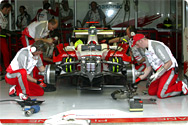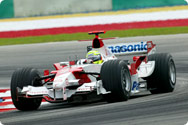Thank you for your support over the weekend. Noritoshi Arai, here, with the Panasonic Toyota Racing report from the Malaysian Grand Prix.
Trying to seize the opportunities presented at the second round
With such a poor showing at the Grand Prix of Bahrain, we approached the race in Malaysia feeling like we had nothing to lose. After Bahrain, we immediately hurried back to TMG home base (Cologne, Germany), and looked into every possible cause of our troubles at the last race. Frankly, we couldn't pin the issue to any one thing. Each individual component by itself seemed to be fine. Throughout winter testing and the race last week, there were no major issues that presented themselves as an obvious cause for problems. In short, we concluded that if each component was fine, then the issue had to be one of overall balance.
Another issue from the prior race is the fact that we didn't run many laps during Friday practice due to all of the sand on the track at the Bahrain circuit. Accordingly, we had no accurate indicator of our position relative to the other teams. This time, we decided to approach Friday practice with a much more aggressive attitude. The heat must have been very tough on our drivers, but we wanted to put more revolutions on the engine, and more laps on the car than we did in Bahrain. Our strategy was to run longer and faster, which would present us with more opportunities to have another look at the basic elements of the car.
At any rate, we did not approach Malaysia with any sense of gloom or doom. We believed we had yet to get the true performance out of our car, and we didn't think that any drastic mechanical changes were called for at that point.
Running an aggressive program from the start
As planned, we drove a very upbeat program beginning with Friday morning's practice session. I think we were able to put some very valuable distances on the cars. Our times could not be construed as extraordinarily fast by any means (Jarno at P11 and Ralf at P17 after the second practice session), and I wasn't exactly thrilled myself, but we did have noticeable improvement. One such improvement was that we were able to use our tires effectively. I knew we had a ways to go yet, but I could feel that we are making steady, if not spectacular, progress.
 |
 |
| Panasonic Toyota Racing approached the Malaysian Grand Prix with an aggressive strategy, testing various aero and suspension configurations, and gaining valuable clues to improved performance. |
|
To a great extent we narrowed the scope of our program in the prior race. This time around we tried a number of different combinations and tactics, keeping our options wide open from the start. We tested several different aero specs and suspension setups. On the aero front, we tried both increased and decreased downforce, while we adjusted camber (vertical angle of tires with respect to the track surface) and toe (horizontal angle of tires with respect to the track surface) to test the suspension equation. After a few laps, for example, it was evident that we had too much camber, so we adjusted to a more vertical setting (tires angled closer to a right angle with respect to the track surface).
After verifying the data we collected, we reflected the findings in our Saturday setup. We had absolutely no engine concerns whatever. We knew we had to take care in temperature management because of the oppressive heat, but we weren't worried.
Keeping on the attack
We thought long and hard about what we wanted to accomplish for Saturday. Ralf felt good about his car's balance, so we didn't make any major changes for him. Jarno's car was still acting nervous out on the circuit, so we made some adjustments and tried them out. There were also a few aero issues unresolved from Friday, so we tried a few different settings. We were able to confirm that our changes were improvements, but nothing translated into quicker lap times. Since we were unable to completely work out the car setup, we put them back in their previous configurations and headed into qualifying.
As soon as the clock started on the first qualifying session, we headed out onto the track. As with Friday, our attitude was to go all out. We used up tires at quite a quick rate. In any event, our goal was to do everything we could to get our drivers to Q3 (third qualifying session).
Ralf had been feeling fairly satisfied with his car the whole day, and I think things went basically according to plan for him. Jarno reported that his car was suffering understeer, se we made some front wing adjustments. In the end, we couldn't get Jarno's car into perfect shape, and he finished P13. We had been running tests during the morning, and I think perhaps we didn't have enough time to do everything needed.
Ralf liked the feel of his car, and just as we were celebrating his advancement to Q3, his car suddenly quit. We have yet to determine the exact cause, but there's no mistake that it's something to do with the engine. As of the end of Q2, Ralf had secured a position among the top ten qualifiers. I was thinking that we might have turned a corner toward success, so I was disappointed.
With many of the other cars also changing out engines, Jarno was able to start among the top ten on the grid, while Ralf, due to his engine change, started at the back. We knew we were in for a tough race, but our goal was to move up and finish as high as possible.
A light at the end of the tunnel
Ultimately, I was happy that we were able to finish in the points, even if it was just one. We fared very poorly in last week's race, but after our finish in Malaysia, I feel like I can see some sun peeking from behind the clouds. Due to the engine failure on Saturday, Ralf had to start from the very back of the grid, but he drove a strong, aggressive race. He even turned in lap times toward the end just as fast as the race leaders. Going into the next grand prix, I feel our prospects are definitely looking up.
Meanwhile, Jarno came in contact with another car during the first stint, damaging his diffuser. The car became tremendously unstable, and Jarno couldn't increase his pace compared to Ralf.
As we stated in our official press release, the fact was that both cars were on a two-stop strategy. The overall impression was that Ralf had an extra stop, but his first pit was quite unplanned. Right off, we could see some signs of abnormalities in Ralf's engine, so he came in quickly and we made adjustments. Who can say how the race would have developed had we not done this. In the end, Ralf was able to run at a great pace even with the unexpected pit stop, so I have to give all credit to the driver and his tenacity.
I have also heard questions about the option of a one-pit strategy, since Ralf was starting at the back of the grid. Actually, Ralf qualified into the Q3 session, so we couldn't load any more fuel than we declared prior to qualifying. We could have gone to a one-stop strategy by having Ralf start from the pit lane, but in our judgment it was a better idea to have him start on the grid. Since Ralf gained a number of positions during this first lap, I would say that we made the right decision.
 |
 |
| |
Starting at the back of the grid, Ralf finished in the points at 8th. Even with an extra unplanned pit stop, Ralf finished much higher and stronger than a week earlier. The team looks to make even greater progress before the third race at the Australian Grand Prix. |
Compared to where we were after the first race of the year, I believe our prospects are much brighter. Still, we have to take a good look to see if the results from the Malaysian Grand Prix reflect our true position. We expect much colder conditions at the next race in Australia, so we will be doing colder temperature testing at Circuit Paul Ricard in southern France. We plan on conducting a full battery of tire and other testing before heading to the Southern Hemisphere, where we will be fighting it out in the third GP of the year.
Thank you all for your continued support, and I will be back with another report after the Australian Grand Prix. |